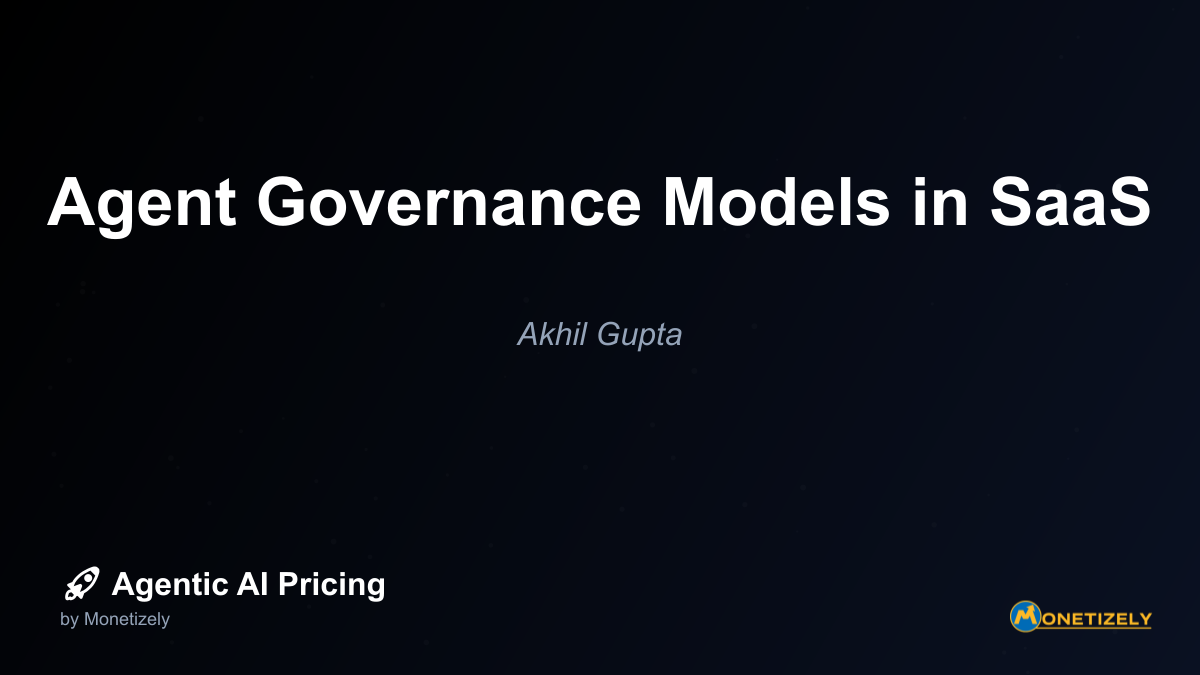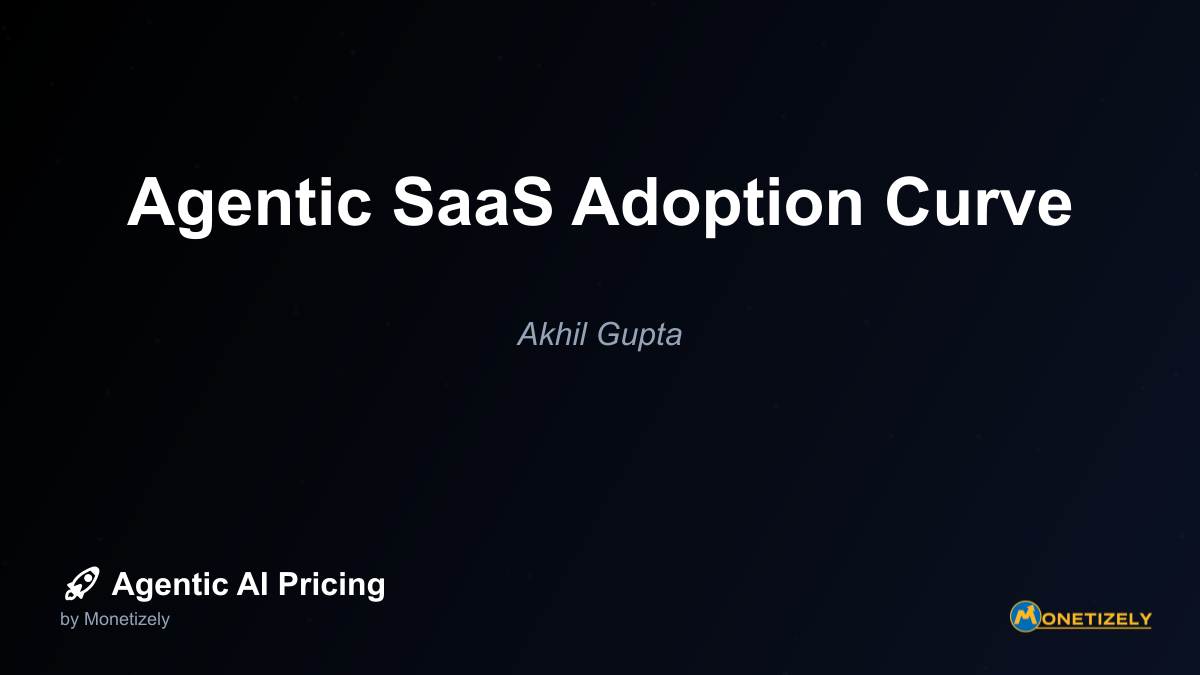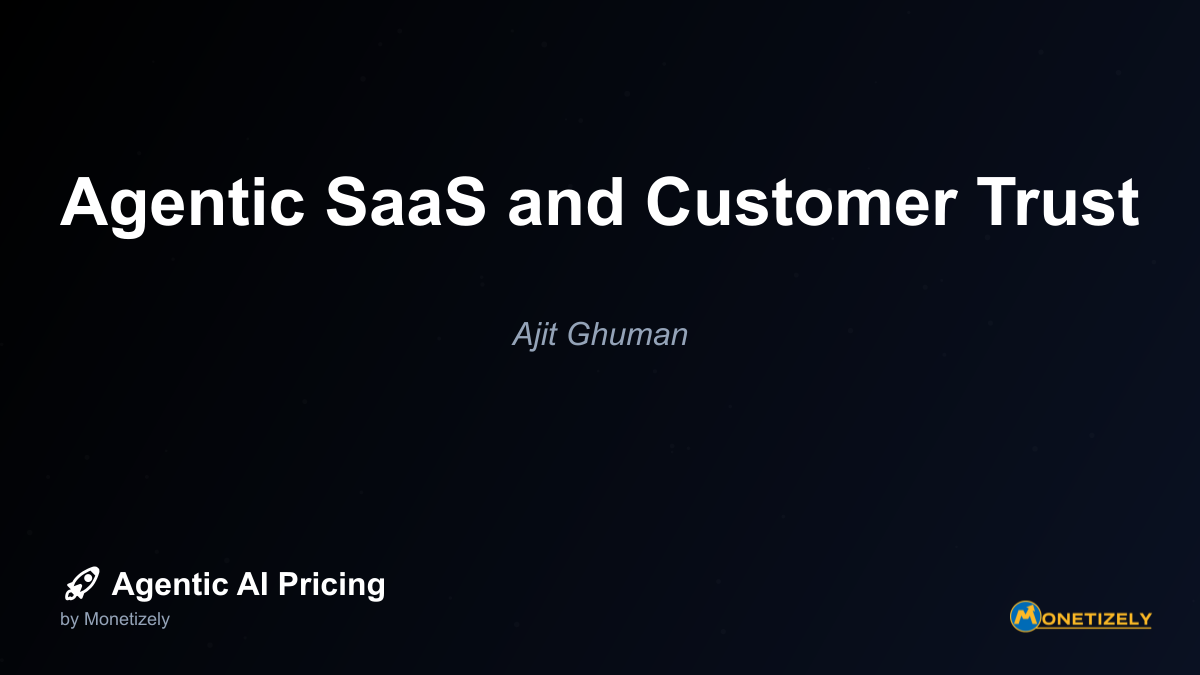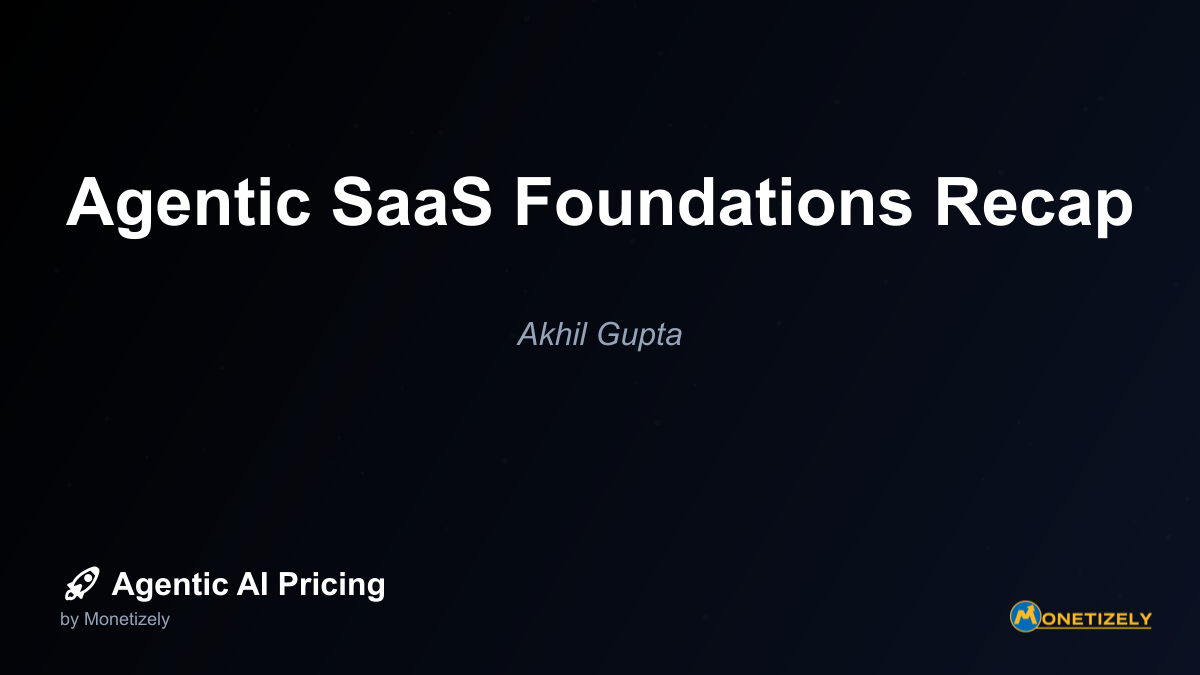· Ajit Ghuman · Agentic SaaS Fundamentals · 11 min read
Why Agentic SaaS is More Than AI Features
AI and SaaS Pricing Masterclass
Learn the art of strategic pricing directly from industry experts. Our comprehensive course provides frameworks and methodologies for optimizing your pricing strategy in the evolving AI landscape. Earn a professional certification that can be imported directly to your LinkedIn profile.
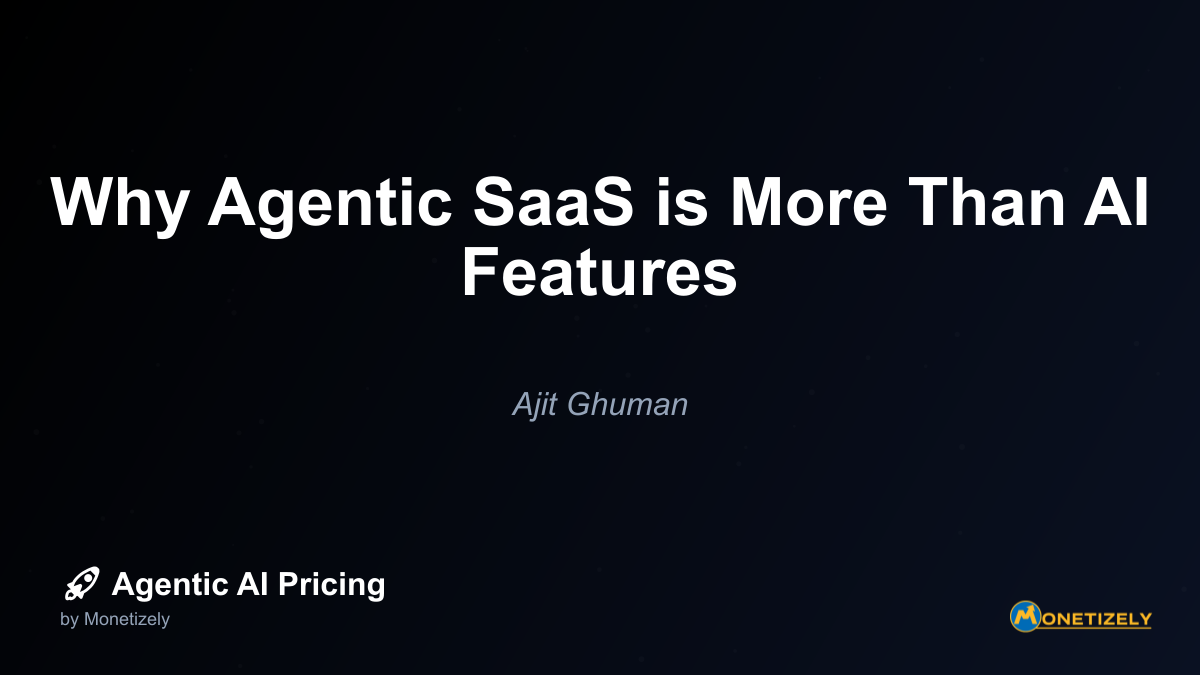
The perception of agentic AI in SaaS products often centers around flashy AI features—chatbots, content generation, or predictive analytics. However, this feature-centric view misses the transformative potential of truly agentic systems. Forward-thinking organizations understand that agentic SaaS represents a fundamental shift in how software delivers value, requiring strategic implementation rather than mere feature addition.
The Feature Fallacy: Why AI Capabilities Alone Fall Short
Many SaaS providers have rushed to incorporate AI capabilities into their platforms, creating a crowded marketplace of seemingly similar offerings. This “AI washing” phenomenon has led to confusion among customers trying to differentiate between meaningful innovation and marketing hype.
“The market is saturated with products claiming AI capabilities, but most are simply embedding basic generative AI features rather than creating truly autonomous, agentic systems,” notes a 2025 McKinsey report that found only 11% of companies claiming AI functionality had deployed genuine agentic capabilities at scale.
The limitations of a feature-centric approach include:
- Siloed functionality: AI features added as afterthoughts often operate in isolation rather than as integrated parts of the workflow.
- Limited autonomy: Features may assist but require significant human intervention and oversight.
- Static implementation: Features remain fixed rather than continuously learning and adapting.
- Generic capabilities: Off-the-shelf AI features fail to align with specific business logic and value drivers.
According to Deloitte’s 2025 Technology Predictions, “Organizations that view agentic AI merely as a collection of features to be added to existing software will miss up to 70% of the potential value creation opportunity.”
Strategic Implementation: The Agentic Advantage
Truly agentic SaaS transcends features by embedding AI agents that autonomously orchestrate complex workflows, make decisions, and continuously optimize based on outcomes. This strategic implementation focuses on business transformation rather than technological novelty.
Autonomous Orchestration vs. Isolated Features
The fundamental difference between feature-based AI and agentic systems lies in their approach to workflow orchestration. While AI features assist with specific tasks, agentic systems can independently manage end-to-end processes.
Consider the contrast between a CRM with AI features and a truly agentic CRM:
Feature-Based CRM:
- AI-powered lead scoring that ranks prospects
- Chatbot that answers basic customer queries
- Email templates with AI-generated content suggestions
Agentic CRM:
- Autonomous agents that identify prospects, personalize outreach, schedule follow-ups, and nurture relationships without human intervention
- Agents that continuously monitor customer health signals across channels, proactively address concerns, and recommend retention strategies
- Systems that autonomously optimize sales processes based on performance data and adapt to changing market conditions
Research from IBM indicates that organizations implementing agentic SaaS solutions report 35% higher productivity gains compared to those using feature-based AI tools, primarily due to the reduced need for human intervention in complex workflows.
Data Integration and Learning Capabilities
Agentic systems differ fundamentally in how they interact with organizational data. Rather than operating on limited datasets for specific features, they integrate across data sources to build comprehensive understanding.
A 2025 study by Bain & Company found that “successful agentic AI implementations connect an average of 7.3 distinct data sources, compared to just 2.1 for feature-based AI solutions.” This comprehensive data integration enables:
- Contextual understanding: Agents can access and synthesize information across systems to make informed decisions.
- Continuous learning: Rather than static models, agents improve through ongoing interactions and feedback.
- Cross-functional insights: Agents can identify patterns and opportunities that span traditional departmental boundaries.
H&M’s implementation of agentic AI in their virtual shopping assistant demonstrates this advantage. By integrating customer interaction data across channels, purchase history, inventory systems, and trend analytics, their agent delivers personalized recommendations that have increased conversion rates by 25% while tripling response speed.
Organizational Transformation: Beyond Technical Implementation
The shift to agentic SaaS requires significant organizational changes that extend far beyond technical implementation. Companies that succeed recognize that agentic AI demands new governance structures, skill sets, and ways of working.
Governance and Oversight
As AI agents gain autonomy, organizations must establish robust governance frameworks to ensure responsible operation. This includes:
- Clear decision boundaries: Defining which decisions agents can make independently versus those requiring human approval
- Performance monitoring: Establishing KPIs that measure both process efficiency and outcome quality
- Ethical guidelines: Creating principles for agent behavior that align with organizational values
- Intervention mechanisms: Developing protocols for human oversight when needed
SuperAGI’s framework for continuous agentic AI improvement in CRM systems exemplifies this approach, establishing baseline KPIs (customer satisfaction, response time), monitoring real-time performance, and enabling iterative optimization within defined parameters.
Workforce Evolution
The introduction of agentic SaaS transforms roles throughout the organization:
- From operators to strategists: Employees shift from executing tasks to defining objectives, setting parameters, and reviewing outcomes
- From coders to orchestrators: Technical teams focus on agent configuration, integration, and optimization rather than feature development
- From managers to governors: Leadership establishes guardrails and priorities rather than directing day-to-day activities
IBM’s implementation of AIOps for IT operations illustrates this transformation. IT staff transitioned from routine alert management to strategic oversight roles, focusing on system architecture and exception handling while AI agents autonomously managed routine incidents and suggested corrective actions.
Measuring Success: Outcomes Over Features
The value of agentic SaaS should be measured by business outcomes rather than feature richness. This outcomes-based approach requires new metrics and evaluation frameworks.
Key Performance Indicators for Agentic Systems
Organizations implementing agentic SaaS should focus on:
- Autonomy rate: Percentage of decisions or actions completed without human intervention
- Resolution completeness: Ability to handle entire processes rather than isolated tasks
- Adaptation velocity: Speed at which the system improves based on feedback and changing conditions
- Business impact metrics: Revenue growth, cost reduction, customer satisfaction improvements directly attributable to agent actions
PayPal’s implementation of agentic AI for payment processing and fraud detection demonstrates this outcome-focused approach. Rather than measuring the sophistication of AI features, they track the system’s autonomous handling of transactions, continuous improvement in fraud detection accuracy, and direct impact on operational costs and customer trust.
ROI Calculation Evolution
Traditional ROI calculations for software investments often focus on efficiency gains and labor savings. Agentic SaaS requires a broader view that includes:
- Strategic agility value: Ability to adapt to market changes and customer needs faster
- Innovation acceleration: New opportunities identified and pursued by autonomous agents
- Risk mitigation: Proactive problem identification and resolution
- Ecosystem effects: Value created through improved partner and customer interactions
According to research from Gigster, “Organizations that implement strategic, outcome-focused agentic AI report 2.7x higher ROI compared to feature-based implementations, primarily due to compounding benefits across business functions.”
Pricing and Business Models: Reflecting Strategic Value
The strategic value of agentic SaaS is increasingly reflected in evolving pricing models that move beyond traditional subscriptions to align with business outcomes.
Value-Based Pricing Approaches
As SaaS companies deploy truly agentic systems, pricing models are evolving to reflect the strategic value delivered:
- Outcome-based pricing: Charging based on specific business results achieved rather than features accessed
- Agent-as-a-service: Pricing based on the number and sophistication of autonomous agents deployed
- Value-share models: Capturing a percentage of the financial impact created by agentic systems
- Credit-based systems: Allocating usage tokens that reflect the complexity of tasks performed by agents
Box’s implementation of credit-based pricing for their AI capabilities demonstrates this evolution. Users receive a monthly allocation of AI credits, with consumption varying based on the complexity and value of agent actions rather than simple feature usage.
Hybrid Models Gaining Traction
Many organizations are adopting hybrid pricing approaches that combine:
- Base subscription: Core platform access with limited agent capabilities
- Usage components: Variable charges based on agent activity and complexity
- Outcome premiums: Additional fees tied to specific business results
GitLab’s pricing evolution reflects this trend, starting with basic AI features at promotional rates before introducing more sophisticated, value-based pricing as their agentic capabilities expanded.
Recent research on agentic AI pricing models indicates that “companies implementing outcome-based pricing for agentic SaaS report 32% higher customer satisfaction and 28% longer retention compared to traditional subscription models.”
Case Studies: Strategic Implementation in Action
Organizations across sectors have demonstrated the strategic advantage of agentic SaaS implementation over feature-focused approaches.
Enterprise Example: IBM’s AIOps Transformation
IBM’s implementation of agentic AI for IT operations demonstrates the strategic advantage over feature-based approaches:
Challenge: Managing complex IT environments with thousands of daily alerts, frequent incidents, and limited staff.
Strategic Implementation:
- Deployed autonomous agents to filter alert noise, correlate related incidents, and suggest corrective actions
- Integrated with multiple monitoring systems, knowledge bases, and infrastructure management tools
- Established governance framework for agent autonomy with clear escalation paths
- Transformed IT team roles toward strategic oversight and exception handling
Results:
- 70% reduction in manual alert processing
- 35% faster incident resolution
- Improved system reliability and reduced downtime
- Enhanced competitive positioning in IT operations market
Key Differentiator: Rather than simply adding AI features to existing monitoring tools, IBM implemented a comprehensive agentic system that autonomously managed the entire incident lifecycle, continuously learned from resolutions, and adapted to evolving infrastructure.
Retail Example: H&M’s Virtual Shopping Assistant
H&M’s implementation of agentic AI for customer engagement shows how strategic implementation delivers superior results:
Challenge: High cart abandonment rates, slow customer service response, and difficulty personalizing recommendations at scale.
Strategic Implementation:
- Deployed autonomous shopping assistants that integrate customer data across channels
- Connected product inventory, trend analysis, and customer history for contextual understanding
- Established continuous learning mechanisms to improve personalization over time
- Restructured customer service workflows around AI-human collaboration
Results:
- 70% autonomous query resolution
- 25% increase in conversion rates
- Tripled response speed to customer inquiries
- Reduced support costs while improving satisfaction
Key Differentiator: Unlike simple chatbot features, H&M’s agentic system autonomously handles the entire customer journey, from initial engagement through purchase recommendation and support, adapting to individual preferences and continuously improving.
Implementation Framework: Moving Beyond Features
Organizations seeking to implement agentic SaaS strategically should follow a structured approach that emphasizes business transformation over feature adoption.
Assessment and Strategy Development
- Business process analysis: Identify complex, multi-step processes that would benefit from autonomous orchestration
- Value opportunity mapping: Quantify potential impact on revenue, costs, and customer experience
- Data ecosystem evaluation: Assess the integration requirements across systems and data sources
- Organizational readiness: Evaluate governance structures, skills, and change management capabilities
Implementation Approach
- Start with bounded autonomy: Define clear parameters and oversight mechanisms
- Focus on end-to-end processes: Prioritize complete workflows over isolated tasks
- Build continuous learning loops: Establish feedback mechanisms and adaptation protocols
- Develop hybrid teams: Combine AI expertise with domain knowledge and strategic thinking
Common Pitfalls to Avoid
- Feature fascination: Getting distracted by AI capabilities rather than business outcomes
- Siloed implementation: Failing to integrate across systems and departments
- Insufficient governance: Not establishing clear boundaries and oversight mechanisms
- Static deployment: Treating agentic systems as fixed products rather than evolving capabilities
According to SuperAGI’s framework for agentic AI implementation, organizations that follow a structured approach focusing on continuous improvement and clear KPIs achieve up to 30% higher operational efficiency and 25% better customer satisfaction compared to ad-hoc implementations.
Future Outlook: The Evolving Agentic Landscape
The distinction between feature-based AI and strategic agentic implementation will become increasingly important as the market matures.
Market Evolution 2025-2027
Research indicates several key trends will shape the agentic SaaS landscape:
- Consolidation of agentic platforms: Emergence of dominant ecosystems that orchestrate multiple specialized agents
- Shift from general to domain-specific agents: Development of highly specialized agents for particular industries and functions
- Increased autonomy thresholds: Expansion of decision-making authority granted to agentic systems
- Integration standardization: Development of common protocols for agent communication and collaboration
By 2027, approximately 50% of enterprises will have deployed agentic AI pilots or proofs of concept, with 33% of enterprise software applications embedding agentic capabilities, reflecting the transition from generative AI to truly autonomous systems.
Regulatory and Ethical Considerations
As agentic systems gain autonomy, regulatory and ethical considerations will become increasingly important:
- Transparency requirements: Mandates for explainable agent decisions and actions
- Accountability frameworks: Clear assignment of responsibility for agent outcomes
- Data governance standards: Protocols for information access and usage by autonomous systems
- Certification processes: Third-party validation of agent capabilities and limitations
Organizations that proactively address these considerations will gain competitive advantage as regulations evolve.
Competitive Dynamics
The strategic implementation of agentic SaaS will reshape competitive dynamics across industries:
- Value chain disruption: Autonomous agents will enable new business models and service offerings
- Capability acceleration: Organizations with advanced agentic systems will innovate faster
- Experience differentiation: Agent-driven personalization will create new customer expectations
- Talent transformation: Competition for skills in agent design, governance, and optimization
Companies focusing solely on feature parity will struggle against those implementing strategic, outcome-focused agentic systems.
Conclusion: The Strategic Imperative
Agentic SaaS represents far more than a collection of AI features—it embodies a fundamental shift in how software delivers value. Organizations that approach implementation strategically, focusing on business transformation rather than technological novelty, will realize significantly greater returns.
The key elements of successful agentic SaaS implementation include:
- Strategic integration: Embedding agents deeply within workflows rather than as surface-level features
- Autonomous orchestration: Enabling end-to-end process management with appropriate governance
- Continuous adaptation: Building systems that learn and improve through ongoing operation
- Organizational alignment: Evolving roles, skills, and structures to leverage agentic capabilities
- Outcome orientation: Measuring success through business impact rather than feature richness
As the market matures, the gap between feature-focused and strategically implemented agentic systems will widen, creating sustainable competitive advantage for organizations that embrace the deeper potential of this transformative technology.
To succeed in the agentic era, leaders must look beyond the allure of AI features and focus on the strategic implementation that drives genuine business transformation. The question is not “What AI features does your SaaS platform have?” but rather “How fundamentally is agentic AI transforming your business operations and outcomes?”
The organizations that answer this question comprehensively will lead their industries in the coming years, while those focused merely on feature parity will find themselves increasingly unable to compete in a market defined by autonomous, adaptive, and strategic agentic systems.
Co-Founder & CEO
Ajit is the author of Price To Scale, a top book on SaaS Pricing and is the Founder of Monetizely. Ajit has led and worked in pricing and product marketing at firms like Twilio, Narvar and Medallia. His work has been featured in Forbes and VentureBeat. Ajit regularly consults with software companies from Seed stage to post-IPO on pricing strategy. Ajit is also a highly-rated co-instructor for 'The Art of SaaS Pricing and Monetization' on Maven.
Pricing Strategy Audit
Let our experts analyze your current pricing strategy and identify opportunities for improvement. Our data-driven assessment will help you unlock untapped revenue potential and optimize your AI pricing approach.

